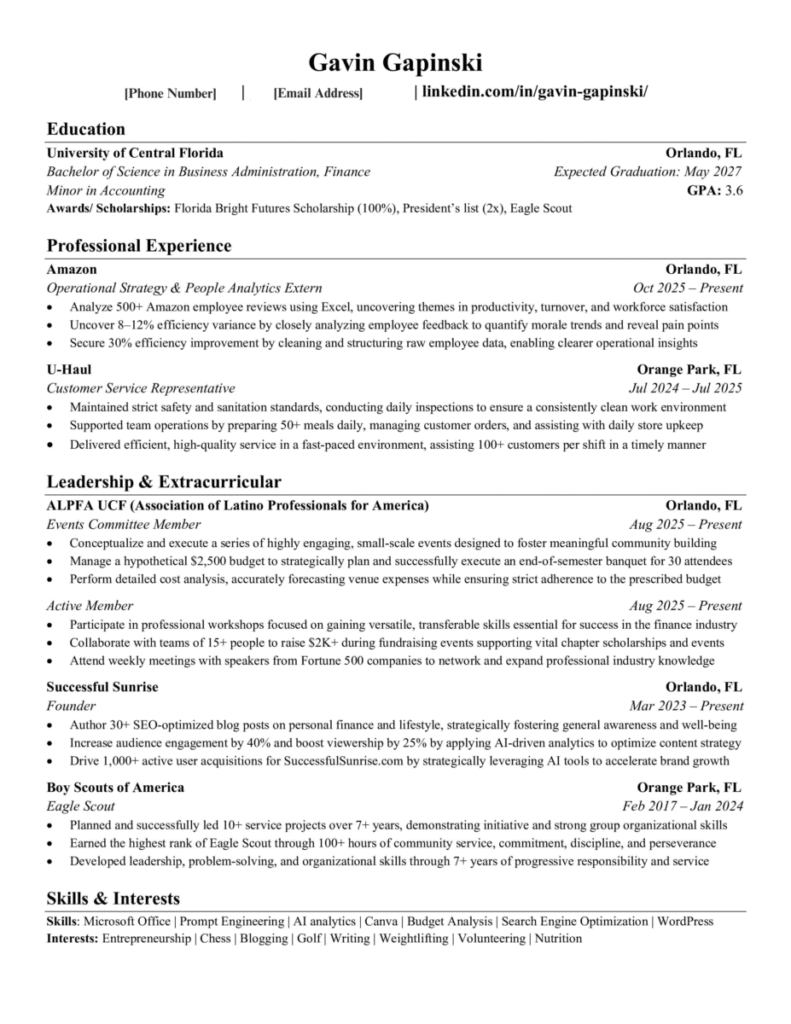
You want a resume for internship applications that actually gets seen in order to get more interviews. Most students wait until the week before a deadline to write theirs. This six-week roadmap breaks the work into small wins so you can stand out. You’ll follow weekly milestones, use proven bullet formulas, and tailor your story to the internships you want.
Why a 6‑Week Resume Plan Works
A strong internship resume is less about formatting and more about strategy. Hiring managers scan very quickly, looking for relevant skills, outcomes, and a clean story. When you spread the work over six weeks, you build content quality (projects, metrics, keywords) and clarity (structure, tailoring), not just a pretty template.
This approach works because it aligns your time with what matters to reviewers and applicant tracking systems (ATS):
- Time to collect proof. You’ll gather numbers, outcomes, links, and artifacts (GitHub, design samples, lab posters) that make claims credible.
- Built-in tailoring. Each week narrows your focus toward the roles you want so your resume for internship aligns with the job.
- Less stress, better quality. Short sprints reduce last-minute edits and typos.
- Feedback loops. You’ll schedule reviews with your career center and peers.
- Keyword alignment. By mining real postings, you’ll echo the language employers use.
You’ll also map your experience to career readiness competencies—skills employers expect in interns (communication, teamwork, problem-solving, professionalism, technology, equity & inclusion, leadership, and career development). Understanding these competencies makes it easier to turn everyday campus work into strong bullets. See the National Association of Colleges and Employers [NACE].
Callout Tip: Think of your resume as evidence, not autobiography. Every line should prove a skill an employer cares about.
Week-by-Week: Resume for Internship Roadmap
Each week takes 45–90 minutes. If you’re in a rush, combine Weeks 1–2 and 5–6.
Week 1: Aim Your Resume
- Pick 3–5 target roles. Read 5–10 internship postings and note common skills, tools, and verbs.
- Create a keyword bank. Pull phrases (e.g., “Python, pandas, A/B testing, SolidWorks, CRM, SPSS”).
- Decide your top 3 strengths. Choose strengths you can prove with projects.
- Collect proof. List links and artifacts you can reference (reports, decks, code, photos of prototypes).
Week 2: Outline & Template
- Choose a clean layout (1 page; clear section headers; consistent fonts). Many career centers offer templates (for example, Harvard OCS resume guides).
- Sections to include: Contact info, Education, Experience, Projects, Leadership/Activities, Skills; optionally Certifications and Awards.
- Write a positioning statement (1–2 lines at the top). Example: “Data-minded Economics junior seeking a Summer 2026 marketing analytics internship; advanced Excel, SQL basics, A/B testing project experience.”
- Education clarity: Include school, degree, grad month/year, major/minor, GPA if 3.5+ or requested. Coursework can help if it proves tools (e.g., “Data Structures, Thermodynamics”).
Week 3: Draft Strong Bullets (XYZ Formula)
Use X–Y–Z: Accomplished X as measured by Y, by doing Z.
- Weak: “Worked on lab experiments.”
- Strong: “Analyzed 1,200+ samples using HPLC, improving turnaround time 18% by automating prep scripts.”
Aim for 3–5 bullets per role/project. Start each with a strong verb, add a number or scope, and end with tools or outcomes. If you truly lack numbers, use scope words: “weekly,” “across 3 sections,” “for 25+ peers,” “two-week sprint,” etc.
Bullet starters to steal:
- Implemented / Designed / Automated / Analyzed / Led / Coordinated / Prototyped / Validated / Deployed
- Reduced / Increased / Accelerated / Cut / Improved / Streamlined / Consolidated
Week 4: Add Proof & Projects
- Quantify: size (users, samples, budget), speed (time saved), quality (error reduction), or impact (adoption, grades, awards).
- Include project links (GitHub, portfolio, Behance, Google Drive view-only).
- Mirror keywords from your bank where genuinely true.
- Projects section: Add 1–3 projects with 2–3 bullets each. Class projects, hackathons, design challenges, or research posters count—if they show tools/outcomes.
Week 5: Tailor for Each Application
- Reorder bullets so the most relevant ones are first.
- Swap a few keywords to match the posting (without overdoing it).
- Match file name & ATS basics:
Firstname_Lastname_Resume.pdf, standard section titles, no text in images. - Mirror the posting’s priorities: If it emphasizes customer support, lead with communication and service outcomes; if it emphasizes analysis, lead with data and tools.
Week 6: Review & Polish
- Peer + career center review for clarity and results-first writing.
- Final proof: consistency, dates, punctuation, spacing, and links.
- Export to PDF and test on mobile.
- Update your master resume with any new experience so tailoring stays fast.
Accessibility note: Always add descriptive alt text and captions to images in your portfolio or linked projects so all reviewers can understand your work.
Tools, Templates, and Examples That Speed You Up
Templates: A simple, single-column layout is easiest to scan and ATS-friendly. Keep margins ~0.5–1 inch and use bold for headings, not graphics. Many university career centers publish solid student templates for resume for internship.
Keyword research: Use occupational databases and real postings to source the language employers use. Paste relevant terms into your keyword bank and echo them naturally in your bullets and skills.
Where to find keywords quickly (and why these help):
- Employer-valued competencies: Review the NACE Career Readiness Competencies to align your bullets with traits employers expect in interns (e.g., teamwork, communication, technology).
- Occupation/task language: Use O*NET OnLine to scan tasks, skills, and tools for your target roles and pull authentic wording.
- Role outlook & duties: Skim the U.S. Bureau of Labor Statistics Occupational Outlook Handbook for responsibilities you can mirror when relevant.
- Networking & portfolio: Use LinkedIn to showcase projects, connect with alumni, and share a featured link to your portfolio or GitHub on your profile.
Mini case: Ana (CS sophomore) Ana had a class project but no “official” job. She turned “built a website” into three evidence-based bullets:
- “Developed a Flask web app serving 200+ monthly users for a study group; implemented login, search, and notes sync; deployed on Render with CI/CD.”
- “Improved page load 35% by optimizing database queries and lazy-loading assets.”
- “Wrote unit tests (pytest) reaching 85% coverage; documented API endpoints for teammates.”
Mini case: Malik (Marketing junior) Malik was the social lead for a student org. He converted activities into outcomes:
- “Planned 4-week Instagram campaign; increased engagement 2.4x and drove 120 email signups using UTM tracking.”
- “Built a monthly content calendar and coordinated 8 creators; maintained brand voice and posting cadence.”
- “Set up Linktree and tagged campaign URLs; attributed 35% of event RSVPs to social sources.”
Sample bullet points by major (customize numbers/tools):
Computer Science / Data
- “Cleaned and analyzed 50,000-row housing dataset in pandas; built linear model (R²=.72) to predict prices; presented findings to 30 peers.”
- “Built React dashboard for lab sensors; reduced alert response time from hours to ~10 minutes by adding real-time WebSocket stream.”
- “Automated grading scripts in Python, cutting TA manual checks by 40% and standardizing feedback.”
Marketing / Communications
- “Planned and executed 4-week Instagram campaign; increased engagement 2.4x and drove 120 email signups using UTM tracking.”
- “Wrote SEO blog posts targeting ‘student meal prep’ (6 articles); raised organic traffic from 0 to 1,200/month in 8 weeks.”
- “Coordinated campus event (150 attendees); secured 5 sponsors and managed $1,200 budget.”
Finance / Accounting
- “Built 3-statement model for student venture; stress-tested scenarios and recommended 12-month cash plan.”
- “Reconciled 300+ transactions in QuickBooks; reduced month-end close from 7 to 4 days by creating a checklist.”
- “Analyzed 10-Ks of 5 comps; summarized key ratios and risks for investment memo.”
Mechanical / Electrical Engineering
- “CAD-modeled fixture in SolidWorks; cut assembly time 25% after 3 design iterations and DFM tweaks.”
- “Prototyped Arduino-based data logger; collected 1M+ samples and visualized with MATLAB.”
- “Ran DOE on 4 parameters; reduced failure rate from 8% to 3% across 200 units.”
Psychology / Social Sciences
- “Designed Qualtrics survey (n=312); cleaned data in SPSS; ran chi-square and ANOVA; co-authored poster accepted at regional conference.”
- “Mentored 12 first-year students; improved study-plan adherence with weekly check-ins and SMART goals.”
- “Coded 25 interview transcripts using thematic analysis; presented findings to department panel.”
Biology / Pre‑Health
- “Maintained cell cultures and ran PCR for 4 assays/week; reduced contamination incidents to zero over 8 weeks by updating SOPs.”=
- “Authored lab wiki pages with step-by-step images; cut onboarding time for new RAs by 30%.”=
- “Assisted in wet lab inventory; implemented barcode system to track reagents and expiry dates.”
Use numbers you can back up; if you’re unsure, write the best estimate and remove the metric during review if you can’t verify it.
Helpful links:
- Map your bullets to employer-valued competencies: NACE Career Readiness Competencies.
- Explore duties/skills to mine relevant keywords: O*NET OnLine.
- Research duties and outlook: BLS Occupational Outlook Handbook.
- Student resume examples and formatting: Harvard OCS Resumes & Cover Letters.
Related reading on our site:
- How to Network With Professors
- 5 Side-Hustles for College Students
- 7 Ways to Get Involves as a College Student
Common Mistakes Students Make (and Quick Fixes)
Mistake 1: Listing tasks, not outcomes.
- Fix: Use the XYZ formula to show scope and results. Add numbers, speed, quality, or impact. This makes your resume for internship applications stand out.
Mistake 2: Vague skills sections.
- Fix: Split into categories (Languages, Tools, Platforms). Only list what you can discuss.
Mistake 3: Overstuffed or empty sections.
- Fix: Prioritize relevance. Move older or unrelated roles under “Additional Experience” with 1–2 bullets.
Mistake 4: Formatting that fights the reader.
- Fix: Stick to one page, consistent punctuation, and simple hierarchy. Use bold sparingly.
Mistake 5: Ignoring keywords.
- Fix: From your keyword bank, mirror 5–7 exact phrases genuinely reflected in your experiences.
Mistake 6: Typos and broken links.
- Fix: Print to PDF, test every link, and read aloud. Ask a friend to review.
Mistake 7: One resume for every job.
- Fix: Reorder bullets and swap a few keywords for each application; keep a master resume.
Mistake 8: Inflated titles or unverifiable metrics.
- Fix: Keep titles accurate (e.g., “Volunteer Tutor,” not “Lead Educator,” unless official). Use ranges or scope words when unsure, or omit the metric.
Mistake 9: GPA confusion.
- Fix: Only include GPA if requested or a strength; specify scale if not 4.0. You can add Major GPA if stronger and allowed.
Action Plan: Quick Checklist You Can Do Today
- Skim five internship postings; list the top 10 recurring skills.
- Draft a one-sentence positioning statement tailored to your target roles.
- Choose a clean resume template and create your section headers.
- Write 6–9 bullets using the XYZ formula (2–3 per role/project).
- Add one link (GitHub, portfolio, Google Drive) that showcases proof.
- Create a keyword bank and insert 5–7 relevant terms naturally.
- Reorder bullets so the most relevant appear first under each section.
- Book a 20-minute review with your career center or a mentor.
- Export to PDF and test readability on your phone.
- Save a master version; duplicate and tailor for each application.
Conclusion
If you follow this six-week roadmap, you’ll build a resume for internship that tells a clear, credible story and resonates with the internships you want. Keep it honest, evidence-based, and focused on outcomes. Start with your keyword bank today, write three strong bullets, and schedule one review this week. Your interviews will follow.
